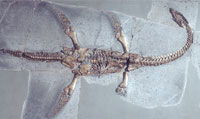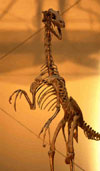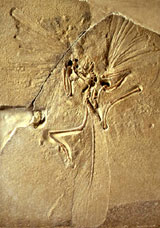Extinct evidence
Video presented by Norm McLeod

The fossil remains of animals and plants tell researchers a lot about what the world was once like.

Most fossils are found in rocks composed of layers of sediments that settled in ancient oceans, lakes, and rivers (called sedimentary rocks). The older sedimentary rocks are found at the bottom of these layered sequences with younger layers at the top. Generally speaking, researchers studying ancient life, known as palaeontologists, look at fossils from rocks lower down in the sedimentary rock sequence. If they want to look at life in the recent past, they search rock layers near the top of the sequence.
When palaeontologists compare fossils to animals that are alive today, they can often see similarities that help identify the relationships between them.
In the late 1800s, palaeontologists discovered evidence that birds are modern descendants of the dinosaurs. Not surprisingly, the fossil that led to this was Archaeopteryx, a dinosaur with feathers.

Archaeopteryx provided evidence that birds evolved from dinosaurs.
However, the fossil record is far from complete. Nearly 150 million years ago an Archaeopteryx flew by an isolated, shallow lagoon and died in these shallow sea beds where its body was buried by the accumulating sediments. Even with these exceptional preservational conditions palaeontologists have found only 10 fossil Archaeopteryx specimens.
There are countless species that live in environments such as jungles and mountaintops, where the bodies of dead animals are more likely to be eaten or broken up than preserved. Therefore, palaeontologists are faced with a daunting challenge: to construct the history of life on our planet with knowledge of only a tiny fraction of the creatures that once lived here.
- Presented by: Norm McLeod
- Date: 10 June 2005
- Duration: 5:14
Got a question or a comment about this video?
To watch video, you'll need to have Windows Media Player or QuickTime installed on your computer.

Our scientists study the snails that host the schistosomiasis parasite, which causes a disease that affects nearly 200 million people.

